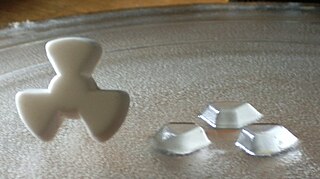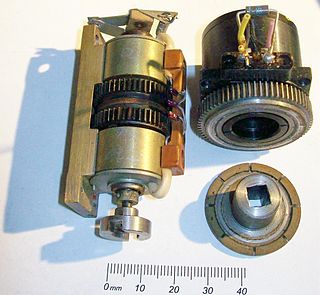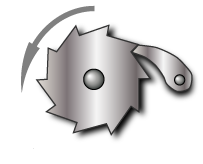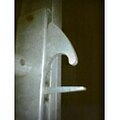
A clutch is a mechanical device that allows the output shaft to be disconnected from the rotating input shaft. The clutch's input shaft is typically attached to a motor, while the clutch's output shaft is connected to the mechanism that does the work.

A fishing reel is a hand-cranked reel used in angling to wind and stow fishing line, typically mounted onto a fishing rod, but may also be used to retrieve a tethered arrow when bowfishing.

A lathe is a machine tool that rotates a workpiece about an axis of rotation to perform various operations such as cutting, sanding, knurling, drilling, deformation, facing, and turning, with tools that are applied to the workpiece to create an object with symmetry about that axis.

An automatic transmission is a multi-speed transmission used in motor vehicles that does not require any input from the driver to change forward gears under normal driving conditions.

A manual transmission (MT), also known as manual gearbox, standard transmission, or stick shift, is a multi-speed motor vehicle transmission system, where gear changes require the driver to manually select the gears by operating a gear stick and clutch.

In mechanical or automotive engineering, a freewheel or overrunning clutch is a device in a transmission that disengages the driveshaft from the driven shaft when the driven shaft rotates faster than the driveshaft. An overdrive is sometimes mistakenly called a freewheel, but is otherwise unrelated.

A limited-slip differential (LSD) is a type of differential that allows its two output shafts to rotate at different speeds but limits the maximum difference between the two shafts. Limited-slip differentials are often known by the generic trademark Positraction, a brand name owned by General Motors and originally used for its Chevrolet branded vehicles.

A sprag clutch is a one-way freewheel clutch. It resembles a roller bearing but, instead of cylindrical rollers, non-revolving asymmetric figure-eight shaped sprags, or other elements allowing single direction rotation, are used. When the unit rotates in one direction the rollers slip or free-wheel, but when a torque is applied in the opposite direction, the sprags tilt slightly, producing a wedging action and binding because of friction.

A lathe dog is a mechanical device typically made of cast iron, steel or aluminum that transmits rotary motion from a faceplate to a workpiece mounted between centers in a lathe. The tail of the dog is rotated by a slot in a driving faceplate, a stud mounted on a faceplate, or sometimes a side of a chuck jaw. The workpiece passes through an aperture in the dog into which the work is secured by one or more setscrews or a clamp arrangement. The maximum cross sectional dimension of the workpiece is limited by the dimensions of the dog aperture. Lathe dogs are provided in straight tail or bent tail form, and may be single tail or double tail. A lathe dog designed to hold square, rectangular or odd-shaped work and having a moveable portion secured typically by two cap screws is called a clamp dog. Bent tail dogs are able to engage directly with a driving faceplate slot or a chuck jaw but can crowd work off centre if clearance is not present between the dog tail and a closed end of the faceplate slot. Straight tail dogs do not present the issue of crowding work off centre but require at least one driving stud to be mounted on the faceplate. If the rotating mass of the dog setup is not balanced, eccentric motion of the work may occur. Counterbalancing or reduced spindle speed may be required. Care must be taken by the operator when using lathe dogs, as it is easy to get snagged on one. Use of headless setscrews, preferably of multiple-spline drive design, that do not protrude above the outer surface of the dog is recommended. A lathe dog may also be used with some indexing heads and other tools with similar faceplates that turn about a center.
The dog is a domesticated canid species, Canis familiaris.

The Rohloff Speedhub is an epicyclic internal hub gear for bicycles, developed and patented by Rohloff AG. It has been manufactured and marketed by that company since 1998. The Speedhub 500/14 has 14 equally spaced, sequential, non-overlapping gear ratios operated by a single twistgrip. The overall gear range is 526%, meaning the highest gear is 5.26 times as high as the lowest gear. Individual gear shifts when shifting up give an increase of about 13.6%.

A torque limiter is an automatic device that protects mechanical equipment, or its work, from damage by mechanical overload. A torque limiter may limit the torque by slipping, or uncouple the load entirely. The action of a torque limiter is especially useful to limit any damage due to crash stops and jams.

A dog clutch is a type of clutch that couples two rotating shafts or other rotating components by engagement of interlocking teeth or dogs rather than by friction. The two parts of the clutch are designed such that one will push the other, causing both to rotate at the same speed and will never slip. In engineering, a "dog" is a tool or device used to lock two components in relation to each other.
Machine – mechanical system that provides the useful application of power to achieve movement. A machine consists of a power source, or engine, and a mechanism or transmission for the controlled use of this power. The combination of force and movement, known as power, is an important characteristic of a machine.

Electromagnetic clutches operate electrically but transmit torque mechanically. This is why they used to be referred to as electro-mechanical clutches. Over the years, EM became known as electromagnetic versus electro-mechanical, referring more about their actuation method versus physical operation. Since the clutches started becoming popular over 60 years ago, the variety of applications and clutch designs has increased dramatically, but the basic operation remains the same today.

A motorcycle transmission is a transmission created specifically for motorcycle applications. They may also be found in use on other light vehicles such as motor tricycles and quadbikes, go-karts, offroad buggies, auto rickshaws, mowers, and other utility vehicles, microcars, and even some superlight racing cars.

A transmission brake or driveline parking brake is an inboard vehicle brake that is applied to the drivetrain rather than to the wheels.

A layshaft is an intermediate shaft within a gearbox that carries gears, but does not transfer the primary drive of the gearbox either in or out of the gearbox. Layshafts are best known through their use in car gearboxes, where they were a ubiquitous part of the rear-wheel drive layout. With the shift to front-wheel drive, the use of layshafts is now rarer.

A pawl is a movable lever that engages a fixed component to either prevent movement in one direction or restrain it altogether. As such, it is a type of latch and can also be considered a type of dog. It typically consists of a spring-loaded lever that engages a mating component at a steep enough angle to restrain it. Pawls are often tapered, being widened at their pivot for anchoring and narrow at their tip.






















